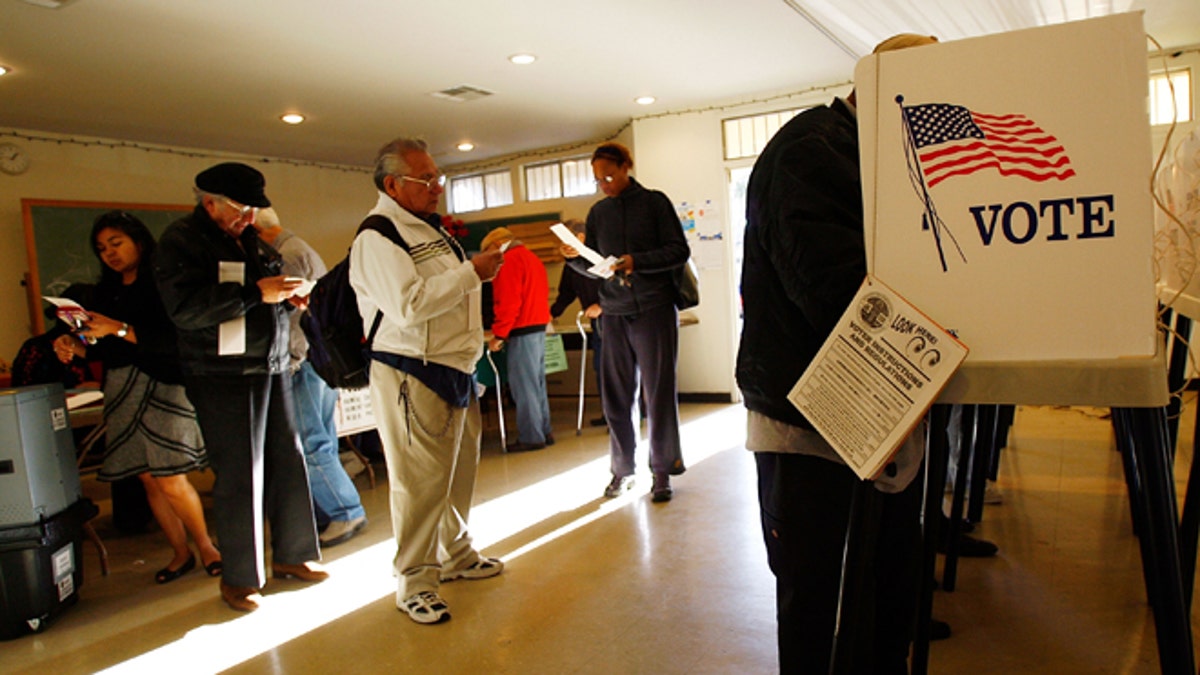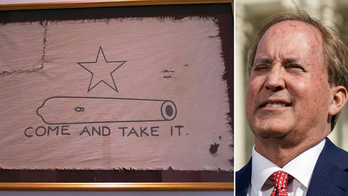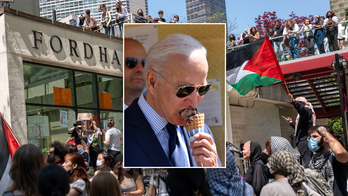
LOS ANGELES, CA - FEBRUARY 05: Voters go to the polls for Super Tuesday primaries in the predominantly Latino neighborhood of Boyle Heights on February 5, 2008 in Los Angeles, California. Latinos are an increasingly important factor in California where they are expected to account for 14 percent of the vote and tend to favor presidential hopeful Sen. Hillary Clinton (D-NY) over rival Sen. Barack Obama (D-IL). At 44 million, Latinos make up15 percent of the US population, the nation's largest minority group according to the latest Census Bureau estimates. (Photo by David McNew/Getty Images) (2008 Getty Images)
Republicans won 35 percent of the Latino vote on Tuesday, thanks in part to a stepped-up nationwide GOP outreach effort that began in earnest after the 2012 election in which Mitt Romney won only 27 percent of the Latino vote.
But other factors also came into play to create a GOP recipe for success, political experts say.
The midterm doldrums – which often produce low turnouts, particularly among certain groups such as young and minority voters – struck again, resulting in older white people accounting for a disproportionate amount of votes. The traditional disillusionment of the party of the sitting second-term president again was a factor.
And among many Latinos, frustration – even anger – over President Obama’s latest unfulfilled promise to overhaul immigration policy kept them home or made them particularly open to what Republicans had to say.
The most important lesson for all, said Alfonso Aguilar, a GOP strategist and former official in the George W. Bush administration, is that Latinos are not beholden to any one political party.
"The message in this election is that Latinos said 'We're not satisfied, we're a more sophisticated Latino community, we're independent,'" and not blindly supportive of any one party, Aguilar said.
The lessons for Democrats, Aguilar and others say, is that they are wrong if they assume the Latino support for them is a given.
Even when a Democratic candidate won a larger share of Latino voters than a GOP rival, in many races, the Republican candidate still won a solid enough share of Latinos to get him or her closer to a victory.
In Texas, for example, gubernatorial candidate Democrat Wendy Davis got 55 percent of the Latino vote, but GOP candidate Greg Abbott, who won, got 44 percent, a significant show of support for a Republican.
That said, however, Republicans should not feel too secure as far as Latinos go, Aguilar added.
“Thirty five percent is an improvement, but the percentage of Latinos voting for Republicans was actually higher in 2010, it was 38 percent.”
George W. Bush got 44 percent of the Latino vote in 2004, Aguilar noted, the result of years – going back to his days as Texas governor – of establishing a rapport with Latinos and making a true effort to understand the complexities of immigration.
So, given that, “I wouldn’t rest on laurels,” he said.
For Republicans, sustaining – and building – Latino support means doing more than avoiding offensive rhetoric and having an enduring presence in ethnic communities, Aguilar said.
“At the end, issues matter,” Aguilar said. “We have to lead on immigration. The issue of immigration is not going away. That doesn’t mean doing Obama’s amnesty, it’s doing something constructive that will include a path to legal status, work visas.”
“In Florida, with the large Puerto Rican community, we can look at Puerto Rican statehood – 64 percent of Puerto Rican voters support statehood for Puerto Rico.”
Jose Dante Parra, a Democratic strategist who headed Latino communications for U.S. Sen. Harry Reid, a Nevada Democrat, in 2010, said despite all the talk of the importance of Latino voters, get-out-the-vote efforts nationwide focused largely on women and white independents.
In Colorado, defeated incumbent Sen. Mark Udall, a Democrat, did not devote enough attention to immigration reform – an issue that his GOP rival, Rep. Cory Gardner, once addressed with a hard line.
Many political experts say that Gardner , who won, was able to soften his tone and refashion the community’s perception of him with little challenge from Udall.
“We always thought this election would come down to how many Latino voters turned out,” Patty Kupfer, managing director of pro-reform group America’s Voice, told MSNBC. “It doesn’t look like the Udall campaign was run [as if] that’s what the election is going to come down to.”
Parra says he was stunned by the Democrats’ losses in Nevada.
“I’m alarmed,” Parra said.
“Both parties, but mostly Democrats, who had the most to lose, were focusing their efforts on red states and appealing to white Independents and female voters,” Parra said. “And the president’s delay with executive action on immigration really dampened enthusiasm with the base.”
“In Nevada, Democrats lost every seat that was up for grabs,” Parra said, “even where Democrats outnumber Republicans by vast numbers.”
A notable example of strong Latino support was Nevada’s race for governor.
Republican Gov. Brian Sandoval nailed 47 percent of the Latino vote, a remarkable improvement from when he first ran and got only 15 percent of their support. Sandoval angered many Latinos back then with his support for Arizona’s tough immigration law – parts of which courts have struck down. But as governor, he’s established or improved programs that have helped win him more Latino support.
One of the biggest common denominators in the Latino apathy in many parts of the country, or their decision to support Republicans, Parra said, was Obama’s inaction on taking executive action on immigration.
Obama exasperated many Latinos by saying several times over the years that he would either get an immigration reform law passed during his presidency, or that he would take unilateral action to what Congress was unwilling to do.
“The biggest issue for Latinos wasn’t so much the inaction,” Parra said, “but raising the expectation then crashing it. You’re better off not saying anything and then surprising people afterward.”




